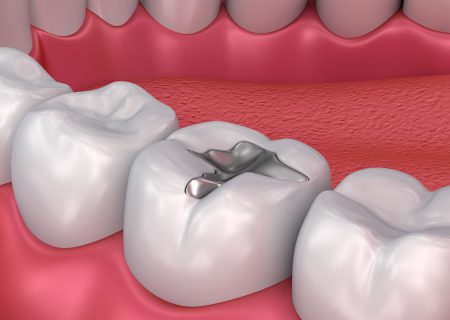Dental Filling
Dental Filling: A Permanent Treatment for Tooth Decay
Dental filling is among the best-known and most effective ways to perform a decayed or damaged tooth. In cases of cavities, a fracture, or collateral damage due to enamel loss, fillings will restore the shape and function of the tooth – disposing of decay further. At Dental Seva we adopt contemporary approaches and materials to ensure a lasting and natural outcome.
Prices of tooth filling can depend on the type of filling material (whether it is a composite, amalgam, ceramic), on location of emptying (whether it is the front, molar, premolar tooth, or the filling of amalgam or metal base is prepared; the farthest filling price is higher due to the increased risk of infection and the problem of determining the existence of a cavity) and general condition of the tooth. At Dental Seva we will have our treatment plans meet your needs and budget up front without compromising on the quality.
What is dental Filling?
Dental filling is a common treatment used to restore missing tooth structure caused by decay, trauma, or habits like teeth grinding or nail biting. It fills the gap created by decay, protects the tooth from further damage, and restores its original shape and function. Fillings are also effective in repairing broken or cracked teeth, reinforcing their structure to withstand chewing forces. In addition to addressing cavities, dental fillings can successfully repair teeth damaged by accidents or trauma. The procedure involves removing decayed or damaged tooth material and filling the space with appropriate dental materials, halting further decay and restoring the tooth’s integrity.

Why would one need dental filling?
Fillings are necessary when tooth decay creates a cavity or hole on the tooth surface. Without a filling, the cavity can worsen and lead to various issues. These include pain, the formation of an abscess, and potentially more severe problems like bone loss. Signs that indicate the need for a filling include:
- Presence of a hole in the tooth.
- Dark spots or discoloration on the tooth surface.
- Food getting stuck in specific areas between the teeth.
- Chipped or broken tooth.
- Sensitivity to hot and cold foods and beverages.
- Identification of single or multiple cavities.
Getting a filling helps prevent further decay, restores the tooth’s function, and alleviates discomfort. It is important to address these signs promptly by consulting a dentist to determine the appropriate treatment, which often involves the placement of a filling.
What is the procedure of Dental Filling?
The dental filling procedure typically involves the following steps:
- Assessment: The dentist evaluates the severity of the decay or damage to determine if a filling is suitable. X-rays may be taken for a more detailed examination.
- Anesthesia: Local anesthesia is administered to numb the area around the infected tooth, ensuring a comfortable experience during the procedure. Nitrous oxide gas (laughing gas) may also be used to help reduce pain and anxiety.
- Isolation: A rubber dam, a small sheet of rubber on a metal frame, may be used to isolate the decayed tooth and prevent debris from entering the mouth and throat.
- Decay Removal: The dentist removes the decayed or damaged portion of the tooth using a dental handpiece or laser. This step prepares the tooth for restoration.
- Filling Application: The dentist applies the chosen filling material to the prepared area to fill the cavity. The type of filling material used depends on factors such as location, aesthetics, and patient preferences. Options include amalgam (a mixture of metals), composite resins (tooth-colored fillings), ionomers (tooth-colored materials with fluoride release), gold, or ceramics.
- Polishing: After the filling is placed, the dentist polishes the tooth to ensure a smooth and natural-looking finish.
It’s important to note that the choice of filling material may depend on factors such as cost, durability, aesthetics, and the dentist’s recommendation. Some materials, like gold and ceramics, may require multiple appointments and additional dental lab support, increasing the overall treatment duration and cost.
Benefits of Dental Filling
Restores Function – Filling a tooth properly allows you to eat, bite and speak with ease, restoring your natural oral functionality.
Halts Decay – A filling will seal a treated cavity and stop bacteria from invading or spreading more decay into the tooth.
Prevents Further Damage – Once again, when treated early, you will reduce the risk of related dental concerns that could require more serious restorative work such as root canals or extraction.
Enhances Overall Appearance – We use a variety of dental fillers for teeth that fall within the range of your natural tooth color.
Dental Does Your Treatment at Dental Seva?
Expert Dentists: We understand that you have genuine concerns about the correct care for your smile, which is why every one of our dentists is very experienced in a range of cosmetic/restorative procedures and is operated to a high level of care for all of our patients.
State-of-the-Art Equipment: Our clinic is equipped with the newest and updated dental technology that guarantees reliable outcome of processes and comfortable treatment.
Customized Care: Whether you have a small cavity or a dental gap filling, we have a structured treatment plan, but we will modify our plans according to your dental structure and cosmetic goals.
Affordable Services: We offer transparent and clear tooth filling price so you can know exactly what you can expect to pay without receiving hidden costs later on. Ultimately, we strive to deliver high quality care to all!
Positive Patient Experience: Whenever you come to our clinic you can be sure that you will have a stress-free visit in a hygiene and patient friendly environment.
Types of Fillings Offered
Composite Fillings: These fillings are able to fit visible teeth and are tooth shaded to ensure the fillings do not look like fillings. These tooth composite fillings are perfect for people who want to guarantee their professional image is powerful and discreet for their clientele while having treatment.
Amalgam Fillings: Amalgam Fillings: They are actually used for back teeth and for the fact, they are very durable, will not shatter or crumble like brittle elements. If you want a long lasting dental filling at a low budget this is a perfect solution as it is of high quality yet durable.
Ceramic Fillings: Ceramic fillings are formed from porcelain, hence a perfect, stain resistant and long lasting option for patients. In addition, they are able to look natural in your own mouth since they mimic the appearance of natural teeth.
Glass Ionomer Fillings: Glass ionomer fillings emit fluoride which prevents decay of the teeth surfaces. These fillings are normally applied on a less intensive area and for children or areas with less strain.
FAQs
The price of fillings largely depends on what type of fillings were used, size of the cavity and whether the cavity was complex or was merely held. The price point of each filling would range from ₹800 to ₹3,000 per tooth in Dental Seva.
No. The accompanying anesthetic will leave the experience almost painless during the treatment.
Unless the person is effluent, his/her average filling could last 5 to 15 years depending on the kind of filling used.
Yes, however, we would suggest waiting with the numbness to pass (a few hours). Especially with a composite filling;)
Common indications that you may need filling include toothache, hot and cold sensitivity, holes or dark spots to your teeth. During your dental checkup this will become more evident.




